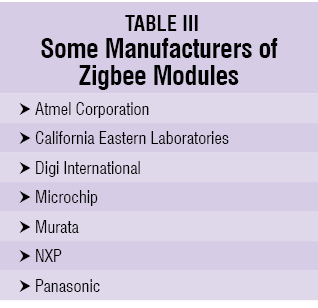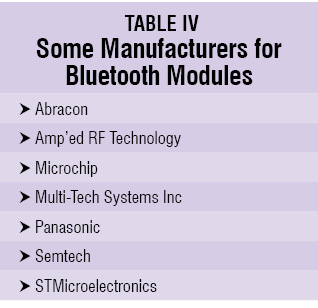Packaging type. Both surface-mount (SMT) and through-hole packages are available for these modules. SMT packages are mostly used for their known advantages, but through-holes are more suitable for testing and prototyping purpose.
Zigbee
These are tiny blue chips that can communicate wirelessly with each other. They can do simple things like replacing a couple of wires in serial communication. There are lots of different modules available but all of them come with similar pin-outs. Power, ground and TX/RX lines are in the same place, making the chips pretty interchangeable for most of the simpler applications.
You will encounter two terms XBee and Zigbee while working with these modules. XBee is nothing but Digi’s (a company) own Zigbee-based protocol. These modules use the IEEE 802.15.4 networking protocol for fast point-to-multipoint or peer-to-peer networking. They are designed for high-throughput applications requiring low latency and predictable communication timing. To select the right module for your application you need to understand things like difference between Series1 and Series2, different antenna types available and what Pro models are.


Series.
Series1 (XBee 802.15.4). A Series1 module does not indicate series on it. Other series modules do indicate it on the chip. So if nothing is mentioned, your module is Series1. Note here that Series1 and Series 2/2.5/ZB hardware are not compatible with each other.
Series2 (Znet 2.5). Series2 modules require configuration unlike Series1 modules. These modules are not compatible with Series1 modules and are not sold any more in the market.
Series2 replacement (ZB). With Znet2.5 discontinued, ZB is often called Series2 module. Though this is not technically correct, it does distinguish these from Series1. ZB is nothing but Znet2.5 with a new firmware which allows it to run in a transparent mode or work with API commands. You also do this upgrade yourself with a conversion kit available on the internet.
Latest Series2 (2B). These modules come with improved hardware as compared to ZB modules with better power usage. These modules run the ZB firmware itself.
Antenna. Antennae available in these modules are chip, wire, u.FL and RPSMA antenna. Chip antenna is nothing but a small chip that acts as an antenna. It is being replaced by trace antenna that is directly printed on the PCB. Wire antenna is just a wire sticking out of the module. u.FL and RPSMA on the other hand are both connector-based antenna systems where your own antenna can be connected through a connector. These are very useful when your object is enclosed in a chassis and you want your antenna outside the enclosure.
Regular vs Pro. The Pro normally consumes more power which directly improves its range. Use the Pro version only when you require better range. But this is a trade-off when it comes to a battery-operated device. So select wisely for the application at hand. Table III show some manufacturers producing these modules.
Bluetooth
Bluetooth is another technology standard for connecting devices wirelessly. The radio-frequency range for Bluetooth is between 2.4GHz and 2.48GHz. It is mostly used for transmitting data in a secured way over short distances, wirelessly. Bluetooth uses a radio technology called Frequency-Hopping Spread Spectrum (FHSS). The transmitted data is divided into packets and each packet is transmitted on one of the 79 designated Bluetooth channels. Each of these 79 channels has a bandwidth of 1MHz, starting at 2402MHz and continuing up to 2480MHz in 1MHz steps. Bluetooth 4.0 uses 2MHz spacing, which allows only 40 channels.
Bluetooth LE

Bluetooth LE, marketed as Bluetooth Smart, is intended to provide considerably reduced power consumption and cost while maintaining a similar communication range as compared to Bluetooth classic. Bluetooth 4.0 specs allow devices to implement Bluetooth LE, Bluetooth classic or both. The devices that implement both the systems are known as Bluetooth 4.0 dual-mode devices. Bluetooth Smart is v4.0 LE only and Bluetooth Smart Read supports dual mode (refer Fig. 1).
The parameters for selection are more or less the same, as already discussed for Wi-Fi and Zigbee. These are data rate, range, power consumption, package and certifications. Table III show some manufacturers for Bluetooth modules. With all the above information, you can easily decide on the wireless protocol and select the best module for your application.
The author is a technical editor at EFY










